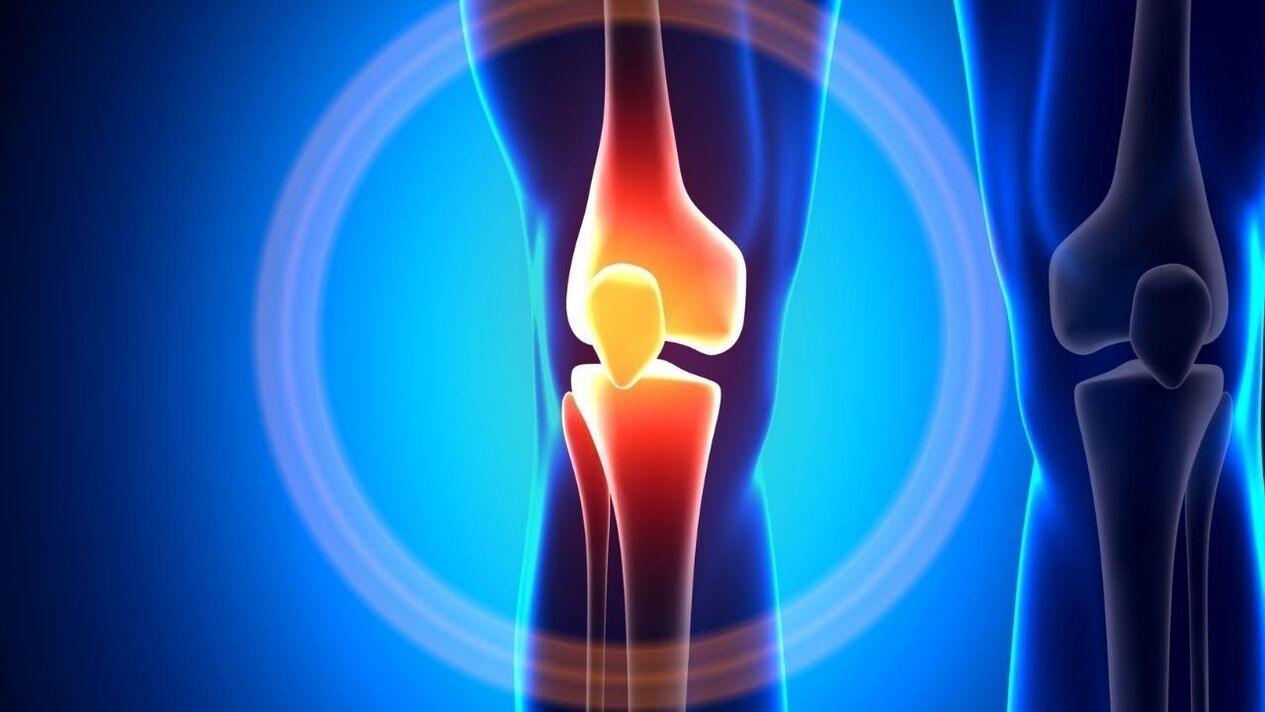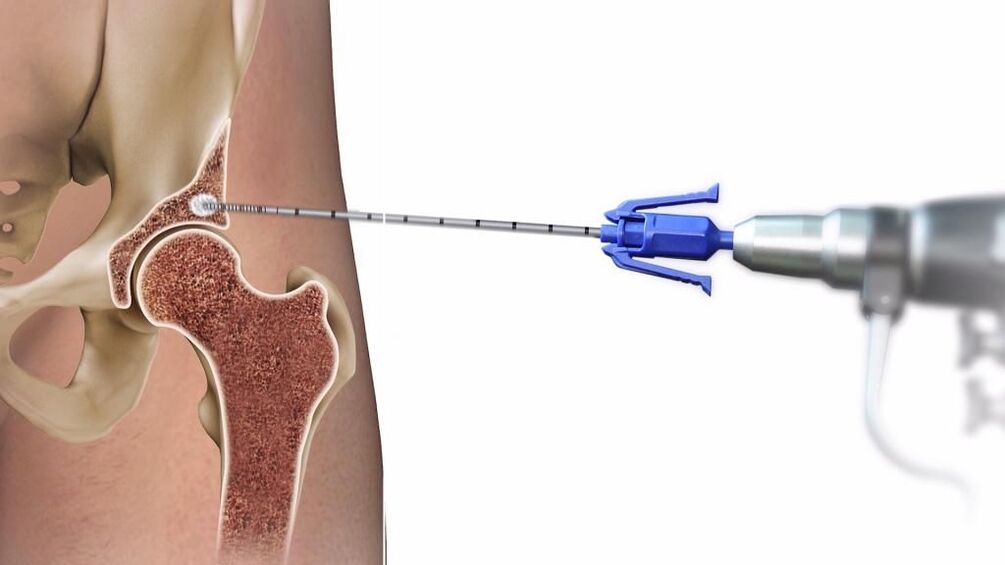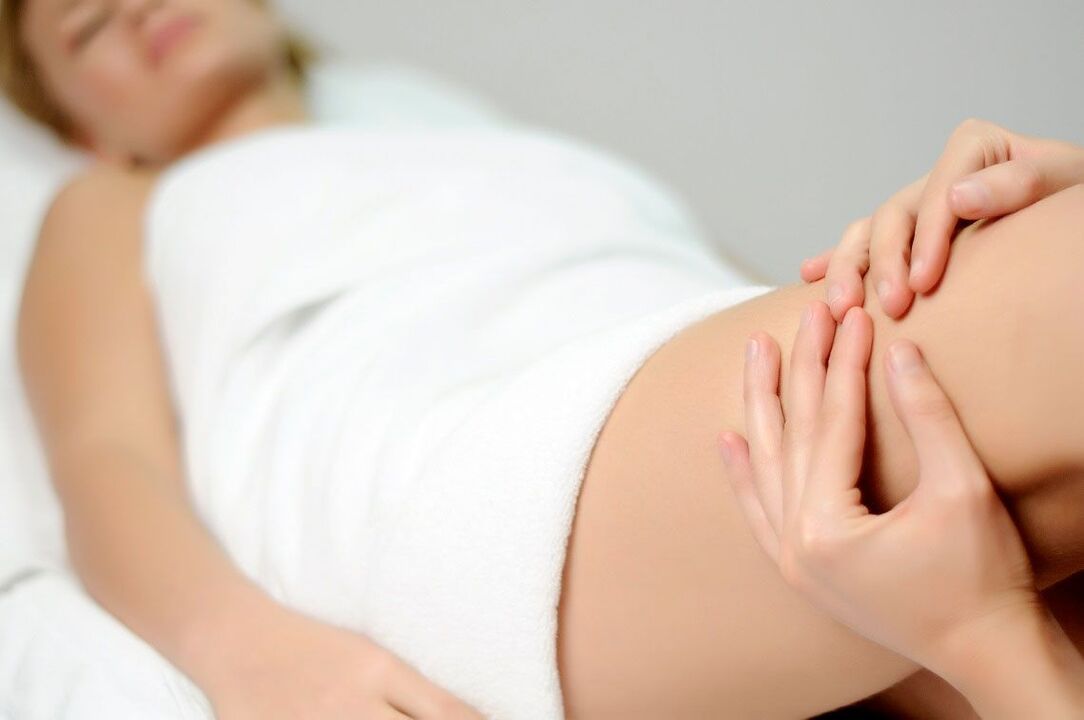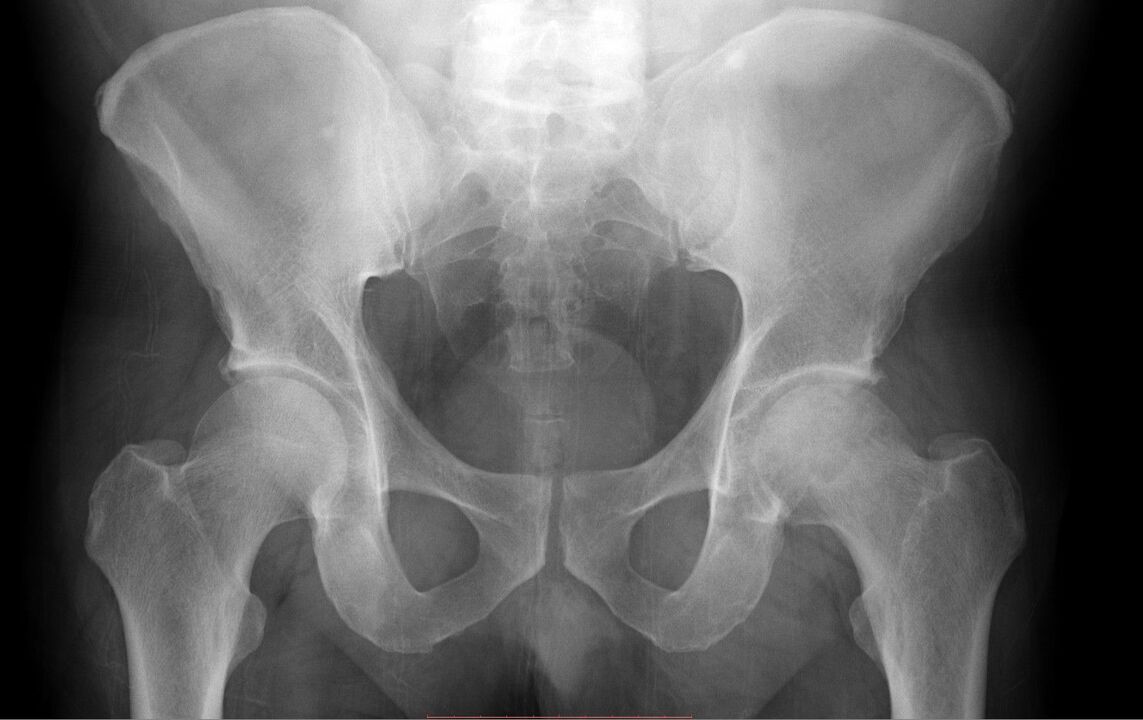Strong, complex structure, resistant to heavy loads, the hip joint is subjected to various pathologies that lead to the appearance and development of pain.

Hip pain is caused by:
- injury;
- infectious infections;
- destructive process in the joint;
- inflammation;
- metabolic disorder.
A person may feel that he "gives" in the groin, buttocks, knees. Perhaps the appearance of limping, muscle atrophy, weakness, limited function of the limbs.
Practice shows that the nature and intensity of pain syndromes can vary:
- start (until you "scatter");
- night;
- dark;
- constant (mild, moderate, strong).
Why does my leg hurt in the hip area?

There are many joint and extra-articular diseases that lead to pain syndromes. Among them:
- coxarthrosis;
- arthritis of a different nature;
- pseudo-gout;
- Kening's disease;
- fractures, dislocations, bruises;
- tendinitis;
- myositis;
- bursitis.
Hip joint pain: which doctor should I go to?

It is clear that some medical conditions that lead to hip pain or numbness cannot be treated by a specialist. Most likely, you should contact your traumatologist or rheumatologist. A consultation with a surgeon may be required. Due to "shooting" pain in the groin, buttocks, lower abdomen, a person may be referred to a neurologist. So coxarthrosis "masquerades" as sciatica, nerve root problems, herniated discs. But the opposite situation is also possible when neuropathies are suspected, but a joint disease is detected.
Women often cannot distinguish the cause of pain in the groin - adnexitis or joint disease. A visit to the gynecologist will bring clarity. A urologist will help a man determine if he has any prostate problems.
diagnostic measures
In medical practice, a well-coordinated plan has been developed, the use of which allows you to fully determine why the hip joint hurts, what to do and how to treat it.
During the first visit, the doctor's job is to collect a medical history. One person was asked about lifestyle, physical activity, to find out if any relatives have joint disease. An external examination of the joint and its palpation is also performed. In the presence of inflammation, this helps to narrow the circle of putative pain-causing diseases.
Furthermore, various laboratory tests and hardware studies are indicated. As a rule, resort to:
- CT scan;
- X-ray;
- Endoscopic.
You will need immunological and microbiological blood tests and a rheumatoid factor test. You may need to have your joint's synovial fluid checked.
Treatments
Because the diseases are quite diverse, it is not possible to treat according to a single regimen. For example, with arthritis of the hip, the symptoms and treatment will be different from what a doctor does when it comes to injury. In the case of a fracture or dislocation, a rheumatologist or surgeon will prescribe a joint immobilization. In infectious and purulent pathologies, a course of antibiotics is required.
Inflammatory and degenerative diseases require the use of the following drug groups:
- non-steroidal;
- diuretic;
- chondroprotectors;
- muscle relaxants;
- vitamin complex.

In this case, the long-term treatment, given in several courses, can last several years. In addition to drug therapy, a person performs exercises, tries to lose weight, undergoes physiotherapeutic procedures. If it is not possible to help the patient with conservative methods, surgical methods must be used.
How painful the hip joint is, a characteristic symptom of diseases that can cause pain, we looked at traditional treatments. However, various joint diseases have been known to man for thousands of years. As a result, traditional medicine has developed a considerable amount of knowledge on how to help patients with joint concerns. Of course, herbal medicines, topicals, compresses, decoctions and tinctures cannot be the main treatment, but doctors recommend it as a supplement to the main therapy. You yourself, without consulting a specialist, you can not drink or apply anything, because there is a risk of allergies, burns or simply wasting time and effort without achieving results. fruit.
Treat hip pain with folk remedies to help relieve colds and nourish the body. Often, alternative medicine offers public ingredients: burdock root, lard, garlic, cinquefoil, dandelion, leaves of the berry bush, buds and fruits. For example, common rosehip broth is a storehouse of vitamin C and is an excellent diuretic that helps remove excess fluid and unnecessary salt, reducing the load on the legs and heart.
Pain spreading down the leg when walking - causes, symptoms
If you feel pain while walkingfemoralcover the body fromlower than beforedown the leg, or is localized in the hip area, you need to see a doctor. Diseases of the hip joints, bearing high loads during the processtake a walk, running, fitness classes, progress rapidly and can lead to disability. For the movement to bring joy and benefit, monitor the health of the musculoskeletal system. If you have symptoms of pain, you need to see a doctor and get treatment as soon as possible. In most diseases, bone tissue, cartilage and joints are destroyed, unable to be restored. You can only eliminate inflammatory processes, prevent or slow down their destruction.
general description
The hip joint is multiaxial, cup-shaped. It combines the pelvis and femur into a single system, allowing a person to walk, lift,Footup and set aside. It works with every step, squat. While the joint is healthy, we do not feel it. But with inflammation, compressionnerve, aching, severe or sharp pain. It is localized infemoral, but as the disease progresses, it spreads,the night it came backInFoot, Inlower than before.
If nottreatmentinflammatory process:
- the size of the joint pocket is reduced, containing synovial fluid - a lubricant in the joint that reduces friction and slows down the wear and tear of the joint;
- damaged joint protective film;
- cartilage and bone tissue are destroyed.
Prevent
It is possible to protect the hip joint from destruction, maintaining mobility into old age if you monitor your health. Diseases of the musculoskeletal system cause excess weight. It increases the load on the joints and they wear out faster. Not only the body weight in kilograms and height, but the ratio of muscle to fat tissue is also important. Strong, workout in the gym, the muscles form a muscular corset that supports the body in an upright position, reducing the load on the spine, hip and knee joints and feet.
The destruction of cartilage and bone tissue occurs when there is a lack of calcium and other trace elements. Include more vegetables, lean fish, dairy products, cheese in the menu. Take a mineral-vitamin complex recommended by your doctor. Avoid injury. Don't wear uncomfortable shoes. Walk more, 2-3 times a weekdoexercises to strengthen and stretch muscles.
Causes of pain
Hipprobablyill:
- after an awkward fall, a blow - if the pain does not go away after 2-3 days, you need to visit a traumatologist,doX-ray;
- with the development of rheumatic diseases - the joints become inflamed, pain is felt at rest and increases whentake a walk;
- with arthritis - soreness, which is worse at night;
- violation of metabolism, blood flow - tissues do not receive enough nutrients, oxygen, the elimination of toxins is delayed;
- if the infection enters - abrasions, abrasions, purulent rash on the thighs can become a gateway for infection, entering the joint, causing acute infectious bursitis with acute unbearable painfloating;
- diabetes, other systemic diseases;
- with inflammatory processes in the body, accompanied by fever or with a risk of spreading to the joints.
It is not possible to make an accurate diagnosis on your own. For pain that does not go away in 2-3 days, you need to see a doctor,dosurvey.
Types of pain
Acute pain in the hip joint occurs with local trauma and inflammatory processes. It can start withthe rightorleft sidelateral, but with the development of inflammation, covering the circumferencehip,the night it came backInlower than before, Infoot. After the examination, the doctor will prescribe anti-inflammatory drugs to help relieve the pain quickly. But sometimes it is necessary to continue treatment after it has disappeared to eliminate the causes of inflammation.
With pain, it is more difficult for a doctor to make an accurate diagnosis. It can arise in one place, and give it to another. If it appears periodically, you need to notice that its manifestations are connected with: at rest, withtake a walk, squatting, sudden movements.
If pain symptoms are present for more than 6 months, the disease has become chronic. To establish the diagnosis, hardware tests are performed: X-ray, ultrasound, MRI,being madeblood analysis.
Diseases and their characteristic symptoms
Painfemoraloccurs with various diseases:
- bursitis;
- osteoarthritis;
- coxarthrosis;
- arthritis;
- tendonitis;
- Nerve pain.
bursitis
Bursitis is an inflammatory process in the joint pocket. It is manifested by acute pain, fever, general deterioration of health. Under the skin, a hot, painful bump forms.HealThis disease is an orthopedic surgeon.
osteoarthritis
A chronic disease in which the bone and cartilage tissues of the joints are destroyed. It develops after trauma, during menopause in women, metabolic disorders, excessive stress in athletes and during heavy work. Feeling tired in the early stagestake a walkpain with sudden movementfeet.If you start treatment at an early stage, the progression of osteoarthritis can be greatly slowed and mobility can be maintained into old age. In the second stage, destructive processes in the joint affectnerve. The pain appears in the morning and disappears in the afternoon. She cangive awayon the knee,lower than before. There is tissue swelling. With the progression of osteoarthritis, pain persists around the clock, mobility is limited.
Coxarthrosis
With coxarthrosis, the composition of the synovial fluid changes. It does not lubricate the components of the joint, each movement feels intense pain, the femoral head is displaced and deformed. The disease develops in old age or after trauma. In the early stages, pain is felt withthe rightorleft sidenext to you while walking. When deformedpinched nerve, pain increases, limping appears. In the third stageleft sideorthe rightLegs are shortened due to deformed femoral head, the difference can be 1-1. 5 cm.
Arthritis
External painhipButts are considered by many to be a symptombone necrosis. But when making a diagnosis, it is necessary to rule out or confirm arthritis by hardware diagnostics. Different types of arthritis were diagnosed: purulent, rheumatic, tuberculosis, psoriatic, reactive.
Tendonitis
Tendonitis - inflammation of the tendons and ligaments manifested by unbearable pain, swelling, redness of the skin, a crunching sound when walking, fever. Inflammatory tissue canheadnerve endings, increasing pain symptoms. It's forbiddentreatmentyour pain reliever. Such treatment can cause complications - the development of tendonitis, when inflamed ligaments begin to collapse.
Nerve pain
If oneHips hurt, give wayburning pain along its lateral surface, additional examinations are performed to confirm neuralgia,pinched nerve causes.
Other symptoms
To understand whether there is pathology in the hip joint or the pain is due to the fact thatosteochondrosis for in the leg, the following symptoms will help:
- when walking, running, bending over, joints crunching or rattling;
- lost flexibility, limited freedom of movement - difficulty bending over, climbing stairs, sitting down;
- body temperature rises,bone necrosisno such symptoms;
- change in gait;
- Symptoms of pain manifest when walking, trying to lift, lift the leg to the side but the movements of the body and hands do not cause discomfort.
pathological diagnosis
Inbone necrosisand diseases of the hip joint with similar symptoms. For an accurate diagnosis, the doctor examines the patient, clarifying the complaints, the nature and localization of the pain. To determine,how to treat diseasewhat drugs are contraindicated to the patient, additional examination is prescribed:
- blood test - it indicates whether there is an inflammatory process in the body, how strong it is;
- urinalysis - reveals hidden edema, disorders in the excretory system, the degree of intoxication of the body;
- blood tests for fibrinogen levels, other nonspecific markers;
- rheumatology test - determine rheumatoid factor;
- proteinogram - reveals inflammatory, malignant and benign processes, characterizes the composition of protein compounds in the blood;
- X-ray - shows the condition of the bones, cartilage, tendons, shows fractures, cracks, breaks, dislocations, degree of destruction or deformity;
- need magnetic resonance or computed tomography to see pathology of soft tissues: muscles, ligaments;
- Ultrasound - shows the condition of the joint, an increase in the volume of the membrane during inflammation, the presence of synovial fluid in various parts of the joint.
Characteristics of pain treatment of different nature
There is no single plan to treat pathologies of the hip joint. Arthritis requires medication only ifpinchednerve endings are different. The doctor after diagnosis will prescribe treatment, taking into account the stage of the disease, gender, age of the patient, other chronic diseases and possible allergic reactions.
The sensations of pain and swelling in arthritis are suppressed by anti-inflammatory drugs. In order for the disease not to progress, the patient takes hormonal drugs. In addition to drug therapy, physical therapy is performed.
Bursitis is treated with non-steroidal anti-inflammatory drugs. If tests show a severe inflammatory process, a direct injection into the joint will be performed. The doctor chooses an injectable solution, after studying the features of the course of the disease, the general condition of the patient's body. With a high risk of complications, a severe course of the disease, treatment with corticosteroids is carried out.
In the early stages of coxarthrosis, treatment with anti-inflammatory drugs is effective. But if the patient does not go to the doctor when he feels thatpainLegs when walking and the disease is advanced, total or partial joint replacement is required. To restore cartilage tissue, chondoprotectors are prescribed.
In the pathologies of the connective tissue, glucocorticosteroids are prescribed.
It is not possible to use strong drugs on your own without a doctor's supervision. During treatment, the doctor monitors the general condition of the body, appoints periodic blood and urine tests.
How to treat hip arthritis?
Infective hip arthritis. Diagnosis and treatment
infectious arthritis- a disease of childhood, and for the hip joint the average age is even lower than that of arthritis of other regions: 70% of cases occur in children under 4 years of age. The younger the child, the more severe the consequences of hip arthritis. A child's refusal to walk is often associated with a bacterial hip joint infection.
In oneresearch, in which the authors excluded all patients who refused to travel due to previous obvious pathology, it was found that 21 out of 22 patients had a bacterial infection as a cause. Osteomyelitis and septic arthritis occurred with equal frequency and accounted for 14 cases out of 22 cases. Discitis also occurs in a significant number of cases.
Get a raisetemperaturepresent in 82% of patients with bacterial infection, but only in 17% of those without infection. The white blood cell count and ESR did not increase.
Pathogenesis of septic arthritis of the hip joint
Inhip infective arthritisDuring inflammation, Staphylococcus aureus is most often sown. Infection usually affects the joint space from the bone marrow cavity in the joint capsule. As a rule, osteomyelitis is of blood origin and affects the metaplasia of the thigh, penetrating through the supply vessels. Infection may appear superficially as a subperiosteal abscess.
Hip arthritisusually develops due to the invasion of pathogens from the foci of osteomyelitis in the femoral neck into the joint capsule. There is a significant difference between the development of the disease in older children and young children. In older children, this disease is often the result of osteomyelitis in the femoral neck. In neonates, it may result from hematogenous spread in generalized sepsis.
articular cartilageunable to withstand the increased pressure in the joint due to the pus produced by the staphylococcus. In addition, staphylococcus produces an activator of staphylokinase, which contributes to the destruction of joint cartilage. Cartilage can resist these forces for 4-5 days before destructive changes begin. Other organisms that can cause septic hip arthritis in children include pyogenic streptococci and Pfeiffer's bacillus.
streptococcal infectionoften accompanied by a much more rapid increase in signs and symptoms. Pfeiffer bacillus infection is often the cause of septic arthritis that develops in children during the first 12 months of life, although it can occur during the first 2 years of life. Gonococcal arthritis should be suspected in young adults.

Clinical picture of infectious arthritis of the hip joint
Frequent,kidYou are admitted to the emergency department with high fever, malaise, and severe pain in the affected hip joint, with significant limitation of motion in all directions and muscle spasms. The child limps or refuses to walk at all. The affected hip is flexed, rotated outward, and abducted. On examination, the patient had pain in the groin area and above the hip joint, and was tender.
Numberswhite blood cellsin synovial fluid averages 57, 000 µl, but can vary from 10, 000 to 250, 000 µl. The shift of the formula to the left is characteristic, blood cultures are positive in more than 50% of cases. The level of mucin in the synovial fluid was reduced in all cases, as was the level of glucose relative to its concentration in the blood in most of the patients examined. Erythrocyte sedimentation rate is usually increased.
In one study, all patients had some degree of soft tissue swelling in the hip area. The younger the child, the more likely he is to detect dilation of the joint space. In another study, many patients initially had normal radiographs. The most typical is a pathological hip dislocation with enlargement of the joint space. Some patients develop osteomyelitis at the proximal femur.
Differential diagnosis of infectious hip arthritis
Infective hip arthritismust be distinguished from other diseases. Transient bursitis may present with severe pain, severe limping, and limited range of motion in the hip. Radioisotope scanning helps distinguish this disease from septic arthritis. If this is not possible, skin traction in the hospital bed will help in the differential diagnosis. A significant improvement in condition with a decrease in symptoms within 24 hours indicates transient synovitis.
If the doctor suspectsinfectious arthritis, the joint should be punctured, the effusion removed, and antibiotic therapy initiated. Hemophilia can be difficult to distinguish, but such patients are often registered with the disease. If this disease is suspected, urgent decompression is indicated to prevent damage to the femoral head from increased intraarticular pressure.
rheumatic attackmay present with significant pain and limited range of motion in the hip joint. As a rule, this disease has arthritis and volatile joint pain, which helps in the differential diagnosis.
Treatment of infectious hip arthritis
Probably the most importantintervalWhat the emergency physician should be aware of is that delay in diagnosing this disease and initiating treatment late will worsen the prognosis and outcome of this disease. In one study, poor outcomes were observed in most cases when treatment was started more than 4 days after symptom onset.
Treatment goals- remove joint effusion to prevent cartilage destruction and adhesion formation, as well as decompress the joint to prevent impaired blood supply to the ends of bones. Adequate doses of parenteral antibiotics are required. Initially, antibiotics from the penicillin group were recommended, but more recently other drugs have been preferred. An important component of treatment is puncture of the joint cavity and washing. The clinician should select the appropriate antibiotic based on the organism most likely to suspect based on the age and characteristics of the patient's onset. Culture and Gram staining play an important role in antibiotic selection.
Usually foundstaphylococcal arthritis, can be treated with methicillin or oxacillin. If gonococcal arthritis in adults is suspected, intravenous penicillin at a dose of 10 million IU/day should be prescribed.
Unfortunately, a way to completely eliminate coxarthrosis has not yet been invented. Even joint surgery does not guarantee that the dystrophic changes will stop there. Of course, the earlier the diagnosis, the easier it is to control the disease and prevent recurrence. With stage 1-2 disease, it is completely possible to live and feel comfortable if you follow some rules and restrictions.
Treatment will be effective only after a comprehensive diagnosis. The goal of the treatment of osteoarthritis in this case is to increase joint space, restore joint performance and, possibly, regenerate cartilage tissue.
If you are experiencing frequent or recurring hip pain, don't turn a blind eye. Will it be possible to detect the disease at an early stage? You can stop the disease and stop its development. If the doctor will please you with the absence of a serious diagnosis, all the better! Continue to lead a healthy lifestyle and don't forget to visit your chiropractor regularly - after all, the first warning bell has sounded.

























